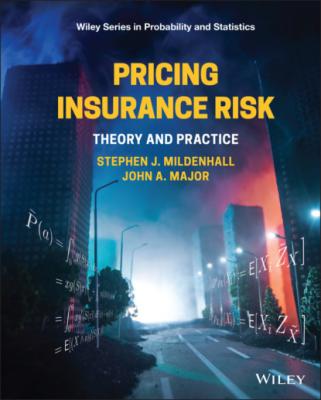Pricing Insurance Risk. Stephen J. Mildenhall
Чтение книги онлайн.
Читать онлайн книгу Pricing Insurance Risk - Stephen J. Mildenhall страница 25

Example 15 Lloyd’s uses an explicit event approach to measure risk because of its intended use of the results. Each syndicate at Lloyd’s reports to the Corporation of Lloyd’s their estimated losses from 16 specific Realistic Disaster Scenarios (RDS), such as a Miami-Dade Florida Windstorm or Japanese Typhoon. The Corporation then aggregates them over all syndicates to determine its total exposure. If Lloyd’s merely asked each syndicate for its 100 year or 250 year loss, it would be unable to determine its aggregate exposure. Rating agencies and regulators evaluate companies on a standalone basis. They do not need to aggregate exposure in this way, and so a dual implicit event, such as a VaR or TVaR loss amount at an extreme return period, fits their intended purpose. The RDS system is described in Lloyd’s (2021). We discuss it further in Sections 5.1 and 5.A.
3.5 The Lee Diagram and Expected Losses
Graphical methods are widely used in mathematics and statistics to visually present ideas which would otherwise be abstruse.
Lee, The Mathematics of Excess of Loss Coverages (1988)
In this section, we present the Lee diagram and use it to illustrate different ways to compute expected and layer losses.
3.5.1 The Lee Diagram
Lee diagrams are introduced in Lee (1988), a famous actuarial science paper. Lee diagrams are a constructive visualization of several important actuarial concepts, and we use them extensively.
Figure 3.2 reproduces the original Lee diagram. It shows claims sorted by ascending size along the horizontal axis and outcome amount on the vertical axis.
Figure 3.2 The original Lee diagram. Source: Lee (1988). Reproduced with permission of the Casualty Actuarial Society.
A Lee diagram plots outcome x on the vertical axis and probability of nonexceedance p=F(x) on the horizontal (label) axis. It is a plot of the dual implicit representation because it labels an event by F(x). The probability F(x) is equivalent to the event rank, between 0 (smallest) and 1 (largest). The Lee diagram can be obtained from the distribution function by reflecting its graph in a 45 degree line through the origin, or (more simply) from the survival function by rotating its graph by 90 degrees counterclockwise about the origin. After rotating, the horizontal axis shows the exceedance probability in reverse order, which is the same as the nonexceedance probability. Figure 3.3 panel (c) shows another Lee diagram.
Figure 3.3 Different ways of computing expected losses for a sample discrete distribution. Each event is equally likely.
3.5.2 Expected Losses and the Lee Diagram
Consider a simple discrete space Ω={ω1,…,ω6} with six equally likely sample points. Let X be the loss random variable defined on Ω with outcomes 1,9,4,4,2, and 4.
The mean loss is 4, which can be seen by summing the losses, 24, and dividing by the number of outcomes or as the probability weighted sum of outcomes 1/6+2/6+4/2+9/6. Five ways of looking at X are illustrated in Figure 3.3.
Figure 3.3 panels (a) and (b) show the explicit representation. The outcomes are labelled by sample point. The two views illustrate that sample points do not have a natural ordering. We can compute the mean by summing over sample points, E[X]=∑ω∈ΩX(ω)Pr(ω). Event probabilities correspond to bar widths. We call this the event-outcome form.
Panel (c) is a Lee diagram. Compared to panel (b), it uses dual implicit labels for each outcome—its probability of nonexceedance Pr(X≤x)—in place of explicit events.
Panel (d) plots the survival (exceedance probability) function, S(x), against the outcome x. The width of the vertical bars equals the difference of the sorted outcome values. Using (d), we can compute the mean in the usual way as the sum-product of loss outcome and probability: ∑ixiPr(X=xi), since Pr(X=xi)=Pr(X>xi−1)−Pr(X>xi)=S(xi−1)−S(xi). Each area is exactly the same as in (c), just rotated by 90 degrees clockwise. We call this the outcome-probability form.
The orientation of the Lee and event-outcome diagrams stresses that the outcome loss is a function of the event rank or description. Lee’s orientation is more natural in many contexts than panels (d) or (e), and is used throughout the remainder of the book.
Panel (e) shows the same function as (d), but uses horizontal bars with heights equal to outcome probabilities, i.e. the differences of the survival function. Using (e), we can compute the mean as E[X]=∫0∞S(x)dx, by considering the chances each width-one outcome layer on the horizontal axis is used to pay a loss. The first layer is always used because all outcomes are ≥1. The second layer is used by five out of six outcomes, so 5/6 probability, the third and fourth by 4/6, etc. There is no possibility of a loss above 9. We call this the survival function form.
The total areas in panels (d) and (e) are the same but are divided up differently.
Converting the expressions for E[X] into integral form yields three equations for the mean:
The first integral corresponds to panels (a) and (b), the second to (d), and the last to (e). When X has a density f, ∫0∞xdF(x)=∫0∞xf(x)dx. Using xdF(x) is more general than xf(x)dx and allows for jumps in F, see Appendix A.4. We prefer to use xdF(x) unless the density exists and needs emphasizing.
The equivalence between the last two expressions in Eq. 3.1 relies on integration by parts, ∫udv=uv−∫vdu, applied with u = x and v = S,